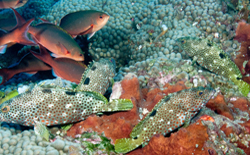In response to dangerous wildfires in Texas, Kathleen Biggins, president and founder of C-Change Conversations, sat down with Climate Central’s wildfire lead Kaitlyn Trudeau on March 8, 2024, to explore how climate change is contributing to longer, more intense fire seasons in the United States.
KB: Wildfires seem to be cropping up in a bigger way, in some unusual places, and causing much more damage than I remember from when I was younger. I wanted to dig down on what role climate change might be playing here. What does the research tell us and what can we expect going forward?
KT: It’s becoming increasingly obvious that the wildfires burning today are much different from the wildfires we’ve experienced in the past. Over the last decade or two, we’ve seen an increase in the frequency and intensity of wildfires in many parts of the world, including the western United States and Canada. In addition to other factors like land management practices and increasing interaction between humans and wildland areas, climate change plays an important role.
Climate change is increasing the frequency of fire weather – hot, dry, and windy conditions that set the stage for extreme fire behavior. You can think of fire weather as a threat multiplier – it’s not necessarily causing a fire to spark but it significantly increases the risk of a dangerous and destructive wildfire should one ignite. Climate Central analyzed historical fire weather trends over the last 50 years and found widespread increases across the western U.S. Some places are now seeing an additional two months of fire weather compared to the early 1970s.
Now, again to be clear, that doesn’t mean there will be two more months of wildfires. It just means there will be two more months of high-risk conditions that would likely produce a much more dangerous and destructive fire than if the conditions were otherwise.
And this is something we see over and over again, including this week in Texas with the Smokehouse Creek Fire. We’re seeing more of these fires that are burning longer, hotter, and faster, adding stress to our already strained resources. And unless we take meaningful action to reduce carbon emissions, we can expect these trends to continue.
KB: I read that in the early days, the Smokehouse Fire was going at a rate of 150 football fields a minute, which was just mind-blowing to try to even envision what that would be like. So when you’re talking about how fast it’s growing, that’s the picture in my mind right now. I know that Climate Central and others have done quite a lot of work with attribution, where we can statistically model out what influence climate change had here, if any. Has that been done for this fire?
KT: At Climate Central we have a daily temperature attribution tool called the Climate Shift Index. It allows you to look anywhere in the world and see if climate change influenced the likelihood of temperatures on any given day. The Smokehouse Fire started in the afternoon on February 26, 2024. Data from local weather stations show temperatures in the area were around 25-30°F above normal – much warmer than expected. According to the Climate Shift Index, those temperatures were made at least three times more likely due to human-caused climate change.
As fire weather becomes more common, it will also reduce the number of days to safely address the issue with things like prescribed burning, which is so important. Specific weather conditions are required to burn and even then, fires can still escape containment. In fact, just a few years ago in 2022, prescribed burns were responsible for what became the largest wildfire in New Mexico state history.
KB: I’ve also read that on these hot and dry days, the military can’t use live ammunition in training, which is really hampering our ability to prepare our soldiers and provide them with crucial live ammunition experience.
KT: That’s really interesting. We briefly looked into trying to get data about Black Flag Days on military bases – basically, the days when outdoor training and exercise can’t be conducted due to the heat and humidity. I haven’t heard about the heat impacting their ability to use live ammunition though. It’s yet another example of ways climate change impacts our world.
KB: So back to Texas, which has always had big fires. This month’s one was the biggest the state has ever experienced, but we’re also seeing much bigger fires in places where we don’t expect it as much – even in Siberia and the Arctic, or the incredible breadth of the forest fires in Canada last year. Why is that? Is it the same phenomenon happening in other places? Or is there a different cause in those geographies?
KT: Generally speaking, I think the same factors are at play – climate change making things hotter and drier – but there are likely other things that have contributed as well. World Weather Attribution published a study on the Canadian fires last year and found the fire weather conditions present across much of the country were made twice as likely due to human-caused climate change.
Living out here in California, we have public safety power shutoffs. So when fire weather is forecasted, utility companies may shut off the power to try and prevent their equipment from sparking a fire. Out here, you don’t even need to be a fire to be impacted by fire weather conditions. It’s a scary thought to lose power during the middle of summer for an unknown amount of time.
The East Coast sees far less fire weather days on average, and hasn’t seen as large of an increase as in the West, but there are places in the East where we are seeing about two more weeks of fire weather each year, including parts of New Jersey and North Carolina.
KB: In southern New Jersey, not even an hour from where I live, the Pine Barrens area is experiencing more destructive fires.
KT: Exactly. It worries me to think about people who live in areas where fires may not be that common – they kind of tune out when these things happen, thinking it doesn’t affect them. While fires are more common in the West, most of the Wildland Urban Interface – the transition zone between developed and wildland areas – is in the East. More people are moving out into nature, into areas where this fire risk is high; where we have more people, we usually have more fires. I know it may seem strange to encourage someone in the East to have a fire plan but when fires break out, you don’t have that much time to think about things.
KB: What can we do? How can we prepare ourselves for a new future of wildfires?
KT: On the individual level, you can do things like make sure you have defensible space around your home. You can even retrofit parts of your home with fire-resistant materials. Make sure you have a way to get emergency alerts, have a plan in case of an emergency – those kinds of things. In terms of the community or organizational level, we can try to do more prescribed burns when possible. We can try to build smarter in our communities, using more fire-resistant materials, and make sure we have sufficient evacuation routes. Check in with your neighbors and those in your community who might need help in an emergency.
Outside of those things – and no one likes this answer – there’s really no substitute for cutting our carbon emissions. What really scares me is thinking about how hard it is becoming for people to get fire insurance or flood insurance for their homes as extreme weather becomes more common. So many insurance companies have already said they can no longer offer policies to people and I can’t help but wonder what people are going to do when disaster strikes and they lose everything with no insurance to fall back on.
KB: We talk about that insurance problem a lot at C-Change, and I did read that many of the people who were harmed in the panhandle of Texas did not have insurance. They will have a really hard time rebuilding. It’s devastating. But as hard as this is going to be for so many people, I do wonder if it will help us grasp how big this risk is. The market is finally beginning to put a realistic price on it – which could help us understand what climate change could mean for our own personal wellbeing and personal wealth, and perhaps slow down our migration to places at high risk.
KT: Absolutely. It breaks my heart thinking about the people who can’t rebuild and terrifies me to think about how quickly that number could rise if we continue to delay meaningful action. So many people seem to think climate change is an issue for another place at another time. But we can’t separate ourselves from nature. What we do impacts the environment and what happens to the environment in turn affects us.
I come from a very conservative county and have realized over the years that the one thing that seems to be waking people up to the realities of climate change is extreme weather. People are looking around their communities and witnessing change in near-real time. I remember when I was younger, we lived in a town that had the most amazing, distinct four seasons. There was a little bit of everything. But over time, things just kept getting warmer and drier and now it feels like a completely different place.
KB: I think some of it is on us, on those of us who are trying to communicate on climate, because climate action has been described in terms of sacrifice. It means giving up your car. It means giving up your burger. It means changing out your gas stove that you love so much. It seems like it’s all about taking things away, when in fact, it’s the opposite. It’s about saving things we love, saving the four seasons, saving the ability to be outside in the summer and not have wildfire smoke or have it be too hot. Saving some of our favorite foods that are under pressure. It’s all about saving, but it’s been painted as about sacrifice. So I’m on a mission to change the way we talk about climate, so more people can really understand it.
KT: I love that. That’s a great way to frame things and connect with people. Who wouldn’t want to save something they love?


